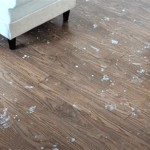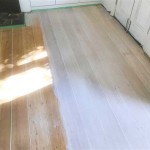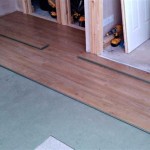How Much Does It Cost To Install Heated Floors In Bathroom?
Heated bathroom floors offer a luxurious comfort, especially welcome during colder months. The decision to install them, however, often hinges on the associated costs. Understanding the various factors that influence the final price is crucial for budgeting and making informed choices regarding materials and installation.
The expense of installing heated floors in a bathroom is not a fixed figure. It's a composite of several elements, including the type of heating system chosen, the size and layout of the bathroom, the flooring material selected, labor costs, and any necessary subfloor preparation or electrical work. Each element carries its own weight in determining the overall cost.
Types of Heated Floor Systems and Their Costs
Two primary types of heated floor systems dominate the market: electric systems and hydronic systems. Electric systems typically involve heating cables or mats embedded within the flooring, while hydronic systems circulate heated water through pipes. The initial cost and long-term operational expenses differ significantly between these two options.
Electric radiant floor heating is generally less expensive to install initially compared to hydronic systems. Electric systems are especially suitable for smaller areas like bathrooms, as they are relatively easy to install and do not require extensive plumbing modifications. The cost of electric systems can range from $8 to $20 per square foot for the materials, excluding installation. This price variation depends on the quality of the heating mats or cables, the manufacturer, and any additional features such as programmable thermostats.
Hydronic radiant floor heating systems involve pumping heated water through tubing installed under the floor. While more expensive to install initially, often ranging from $15 to $30 per square foot for materials and professional installation, hydronic systems can be more energy-efficient in the long run, particularly for larger areas or homes with existing boiler systems. The complexity of hydronic systems requires professional installation, which adds to the overall cost. The expenses also include the cost of connecting to the existing plumbing and heating system, which can vary depending on the accessibility and layout of the home.
The size of the bathroom significantly impacts the material cost for both electric and hydronic systems. A small powder room will naturally require less material than a large master bathroom. Accurate measurements are crucial for determining the required amount of heating cables, mats, or tubing. Wastage should also be factored in; it's advisable to order slightly more material than initially calculated to account for cuts and errors during installation.
Smart thermostats and control systems add an extra layer of expense but can contribute to long-term energy savings and convenience. Programmable thermostats allow homeowners to set different heating schedules based on their routines, optimizing energy usage and minimizing unnecessary heating. Some advanced thermostats can even be controlled remotely via smartphone apps, offering greater flexibility and control. The cost of programmable thermostats ranges from $50 to $300 or more, depending on the features and brand.
Flooring Material and Installation Considerations
The type of flooring material chosen for the bathroom also affects the overall cost of installing heated floors. Certain materials are more conductive and compatible with radiant heating than others. Tile, stone, and concrete are excellent conductors of heat and are frequently used with radiant floor heating systems. These materials readily absorb and radiate heat, providing optimal comfort.
Ceramic and porcelain tile are popular choices for bathrooms due to their durability, water resistance, and thermal conductivity. The cost of ceramic or porcelain tile ranges from $3 to $20 per square foot, depending on the quality, style, and design. Installation costs for tile can vary from $5 to $15 per square foot, depending on the complexity of the design and the experience of the installer. Stone tiles, such as marble, granite, or slate, offer a more luxurious look but are generally more expensive, ranging from $10 to $50 per square foot for the material and $8 to $20 per square foot for installation.
Engineered wood and laminate flooring can also be used with radiant floor heating, but it's important to select products specifically designed for this purpose. These materials are less conductive than tile or stone, so the heating system may need to be adjusted to compensate. Solid hardwood flooring is generally not recommended for use with radiant floor heating due to its tendency to expand and contract with temperature changes, which can lead to warping and damage. The cost of engineered wood or laminate flooring ranges from $3 to $15 per square foot for the material and $3 to $10 per square foot for installation.
Vinyl flooring, particularly luxury vinyl tile (LVT) and luxury vinyl plank (LVP), is another popular option for bathrooms. These materials are water-resistant, durable, and relatively inexpensive. LVT and LVP are also compatible with radiant floor heating, but it's important to check the manufacturer's recommendations to ensure compatibility. The cost of LVT and LVP ranges from $2 to $10 per square foot for the material and $2 to $8 per square foot for installation.
Carpet is generally not recommended for use with radiant floor heating due to its insulating properties, which can impede heat transfer. However, some low-pile carpets with a thin backing may be suitable for use with radiant heating systems. It's crucial to consult with a flooring expert and the heating system manufacturer to ensure compatibility.
Labor Costs, Subfloor Preparation, and Electrical Work
Labor costs constitute a significant portion of the overall expense of installing heated floors. Professional installation is generally recommended, particularly for hydronic systems, to ensure proper installation and avoid potential problems. Electric systems can be installed by experienced DIYers, but it's essential to follow the manufacturer's instructions carefully and comply with all local building codes.
The cost of labor varies depending on the location, the complexity of the project, and the experience of the installer. Expect to pay between $50 and $150 per hour for professional installation. Complex installations, such as those involving custom designs or difficult layouts, may require more time and expertise, increasing labor costs.
Subfloor preparation is often necessary before installing heated floors. The subfloor must be clean, level, and structurally sound to provide a stable base for the heating system and flooring. If the existing subfloor is damaged or uneven, it may need to be repaired or replaced. Subfloor preparation can add to the overall cost of the project, depending on the extent of the work required.
Electrical work is another essential consideration when installing heated floors, particularly with electric systems. A dedicated electrical circuit is typically required to power the heating system, and an electrician may need to install new wiring or upgrade the existing electrical panel. The cost of electrical work can range from $100 to $500 or more, depending on the complexity of the job and local labor rates.
Permits may be required for installing heated floors, depending on local building codes and regulations. It's important to check with the local building department to determine whether a permit is necessary and to ensure compliance with all applicable codes. Failing to obtain the necessary permits can result in fines and delays.
The removal and disposal of existing flooring can also add to the overall cost. If the existing flooring needs to be removed before installing the heated floor system, factor in the cost of removal and disposal. This can range from $1 to $5 per square foot, depending on the type of flooring and the disposal fees in the area. Proper disposal of old flooring materials is important to minimize environmental impact.
In summary, the cost to install heated floors in a bathroom varies greatly depending on the type of heating system, flooring material, labor costs, and other factors. While electric systems generally have a lower upfront cost, hydronic systems can be more energy-efficient in the long run. Selecting the right flooring material, preparing the subfloor, and ensuring proper electrical work are all essential steps in a successful installation. Thorough research and careful planning are crucial for staying within budget and achieving the desired results.

Heated Bathroom Floors Installation Cost For Homes In Tucson

Heated Floors In Bathroom Tips And Costs Warmlyyours

How Much Does Radiant Floor Heating Cost 2025

Heated Floors In Bathroom Tips And Costs Warmlyyours

Cost To Heat Tile Floor

How Much Does Radiant Floor Heating Cost 2025

Costs Benefits Of In Floor Heating Ahs

Cost To Install Heated Floor In Bathroom

Radiant Heat In Your Home Is It Worth

Schluter Ditra Heat Heated Bathroom Floor Concord Carpenter
See Also







